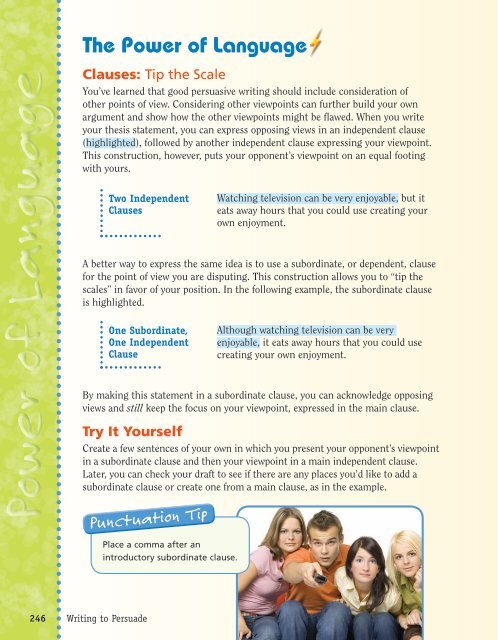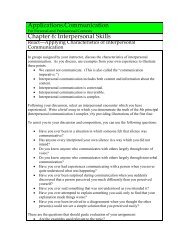Grade 6 - Perfection Learning
Grade 6 - Perfection Learning
Grade 6 - Perfection Learning
Create successful ePaper yourself
Turn your PDF publications into a flip-book with our unique Google optimized e-Paper software.
Power of Language<br />
The Power of Language<br />
Clauses: Tip the Scale<br />
You’ve learned that good persuasive writing should include consideration of<br />
other points of view. Considering other viewpoints can further build your own<br />
argument and show how the other viewpoints might be flawed. When you write<br />
your thesis statement, you can express opposing views in an independent clause<br />
(highlighted), followed by another independent clause expressing your viewpoint.<br />
This construction, however, puts your opponent’s viewpoint on an equal footing<br />
with yours.<br />
Two Independent<br />
Clauses<br />
Watching television can be very enjoyable, but it<br />
eats away hours that you could use creating your<br />
own enjoyment.<br />
A better way to express the same idea is to use a subordinate, or dependent, clause<br />
for the point of view you are disputing. This construction allows you to “tip the<br />
scales” in favor of your position. In the following example, the subordinate clause<br />
is highlighted.<br />
One Subordinate,<br />
One Independent<br />
Clause<br />
Although watching television can be very<br />
enjoyable, it eats away hours that you could use<br />
creating your own enjoyment.<br />
By making this statement in a subordinate clause, you can acknowledge opposing<br />
views and still keep the focus on your viewpoint, expressed in the main clause.<br />
Try It Yourself<br />
Create a few sentences of your own in which you present your opponent’s viewpoint<br />
in a subordinate clause and then your viewpoint in a main independent clause.<br />
Later, you can check your draft to see if there are any places you’d like to add a<br />
subordinate clause or create one from a main clause, as in the example.<br />
Punctuation Tip<br />
Place a comma after an<br />
introductory subordinate clause.<br />
246 Writing to Persuade

















